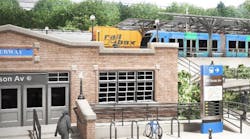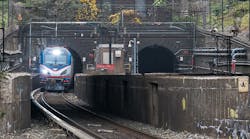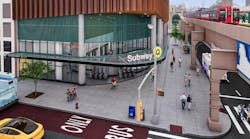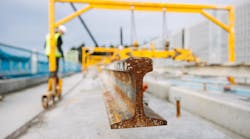OP-ED: Challenges ahead for New York Gov. Hochul's $5.5 billion Light Rail Interborough Express Connector
In 2022, New York Gov. Kathy Hochul announced the Metropolitan Transportation Authority (MTA) will move forward with the proposed Brooklyn Queens Light Rail Interborough Express Connector project. It continues to be wishful thinking. That same year, MTA Chairman Janno Lieber said the estimated cost would be under $10 billion. The current cost estimate of $5.5 billion for selection of light rail versus subway or commuter rail leaves much to be desired. The final price tag will be higher as the MTA has a history of low balling project costs by hiding both financing and debt service payments under the agency operating rather than capital budget.
No details have been provided for the basis to justify this cost or funding sources to pay for it. Neighboring New Jersey Transit has first hand experience in design, construction, operations and maintenance of both the Hudson River and Newark Elizabeth light-rail systems. MTA does not posses the same.
The project was not included in the MTA's 2023 Program of Projects February 7th, 2023 Public Hearing for potential Federal Transit Administration (FTA) funding. The FTA will be providing close to $1.8 billion under various formula and competitive discretionary grant programs in 2023. We do not know how serious the MTA is about going forward with this project. It would have to be included in the upcoming 2025 - 2044 Twenty Year Capital Needs Plan. The MTA promised to release this on Oct. 1, 2023.
Gov. Hochul previously directed Lieber months ago to immediately move the project forward by initiating the National Environmental Protect Act (NEPA) review. So far, all we have had to date is a series of virtual public outreach meetings. This is one of the first steps necessary to quality for future FTA funding.
Hochul recently announced the hiring of WSP USA Inc. to manage the NEPA process. The project director admitted the environmental review process will not start for several months and take two years to complete. The environmental review will be a complicated and time consuming Environmental Impact Statement (EIS). It could easily take two or more years from start to finish, given the complex project scope of work. There is no public schedule to include the anticipated date for receipt of a positive NEPA finding from FTA.
The estimated $5.5 billion project cost based upon starting construction in 2027 will have to be refined as progress proceeds beyond the environmental phases into final design and engineering. Value engineering, a process used to reduce costs, would be used during the final design phase. History has shown that estimated costs for construction usually trend upwards as final design advances. Progression of final design defines the detailed scope of work necessary to support construction. Final design and engineering for construction of stations, elevators, escalators, track, signal, power, relocation of 45 bridges, purchase of vehicles, maintenance, operations and vehicle storage facility along with other major project components could take years.
Costs would be further refined by award of construction contracts followed by any unforeseen site conditions and change orders to the base contracts during the construction phase. There will need to be additional contracts for procurement of vehicles and independent project management engineering construction firms to assist MTA in oversight for both actual construction and purchase of vehicles. The anticipated final cost for the Interborough Express line can never be known until completion of all work and final payments to all the project contractors.
The proposed route runs from Jackson Heights, Queens and terminates in Bay Ridge, Brooklyn will traverse numerous neighborhoods impacting several hundred thousand people living nearby. There are serious legal and operational issues to be resolved with the Federal Rail Road Administration. They have regulatory jurisdiction over significant portions of the proposed route, which would run adjacent to existing active freight tracks. Light rail and freight trains have to coexist on the same narrow corridor.
Project costs will include a series new subway stations with elevators and escalators. This is necessary to provide transfer capacity with 15 subway and two Long Island Rail Road stations that intersect along the route. Each connecting subway or commuter rail station could easily cost from $50 to $100 million (Imagine the costs of escalators and elevators to be in compliance with ADA). Add to that -- new track, communications and signal systems, power, power substations and a hundred or more new light-rail cars ($2 million per car). This additional fleet would require construction of a new maintenance, operations and storage yard for several hundred million dollars. What community would be willing to host such a facility?
There are also costs for reconstructing forty five bridges, widening miles of embankment and viaduct to make space for additional tracks, renovating the 150-year-old East New York tunnel to meet operational and safety requirements, relocating portions of the Buckeye pipeline. There is also a potential serious conflict at the Bay Ridge, Brooklyn terminus. This is also a site for a connection to the proposed $10 billion Cross Harbor Freight Tunnel project.
The most obvious source of funding from Washington would be requesting and being granted permission from the FTA to enter its Capital Investment Grant (CIG) New Starts Core Capacity Program. The project was not included in the latest FTA CIG report submitted to Congress in March 2023 for federal fiscal year 2024.
Gov. Hochul also plans to ask the MTA to enter this project into the FTA Capital Grants Core Capacity New Starts process for future funding. For a project of this size and cost, it can average five years before MTA would complete this process from start to finish. Upon completion, FTA would offer the MTA a CIG Full Funding Grant Agreement (FFGA). This process was used to fund both the MTA Long Island Rail Road East Side Access to Grand Central Madison and New York City Transit Second Avenue Subway Phase 1. There are three critical requirements under the CIG:
- MTA has a dedicated local share to match the federal share under the FFGA.
- Legally has to cover any cost overruns as the FFGA caps the total federal share of costs.
- There is sufficient local funding upon project completion to maintain and operate the new transit system capital investment and service.
How will the MTA comply with this with the looming multi billion multi year ongoing financial deficit and growing long term debt currently at $48 billion in future years?
Anticipated daily riders upon opening of service between 74,000 to 88,000 is based upon transportation ridership forecasting modeling which will have to be periodically updated. The same holds true for anticipated 115,000 daily riders in 2045.
These numbers may be overly optimistic. The service plan calls for five-minute headway between trains at rush hour and 10-minute headway off peak. There is no available information concerning operating costs to subsidize this level of service. How will the MTA find these additional funds within their operating budget upon start of service?
Completion of the planning feasibility study is just the first of many steps. Based upon past history for other MTA mega projects, even if the funding is eventually found, don't be surprised if it requires another 15 to 20 years before opening day of service.
------------------
Larry Penner is a transportation advocate, historian and writer who previously served as a former director for the Federal Transit Administration Region 2 New York Office of Operations and Program Management. This included the development, review, approval and oversight for billions in capital projects and programs for New Jersey Transit, New York Metropolitan Transportation Authority, NYC Transit bus, subway and Staten Island Railway, Long Island and Metro North railroads, MTA Bus, NYCDOT Staten Island Ferry along with 30 other transit agencies in New York and New Jersey.
------------------

Larry Penner
Larry Penner is a transportation advocate, historian and writer who previously served as a former director for the Federal Transit Administration Region 2 New York Office of Operations and Program Management. This included the development, review, approval and oversight for billions in capital projects and programs for New Jersey Transit, New York Metropolitan Transportation Authority, NYC Transit bus, subway and Staten Island Railway, Long Island and Metro North railroads, MTA Bus, NYCDOT Staten Island Ferry along with 30 other transit agencies in New York and New Jersey.






